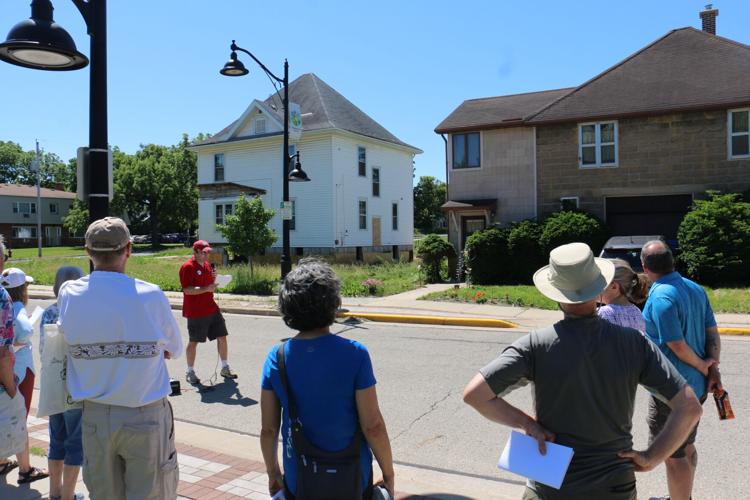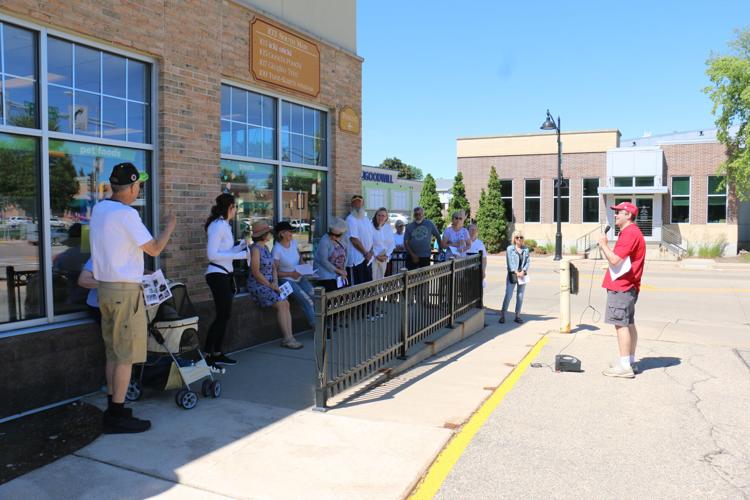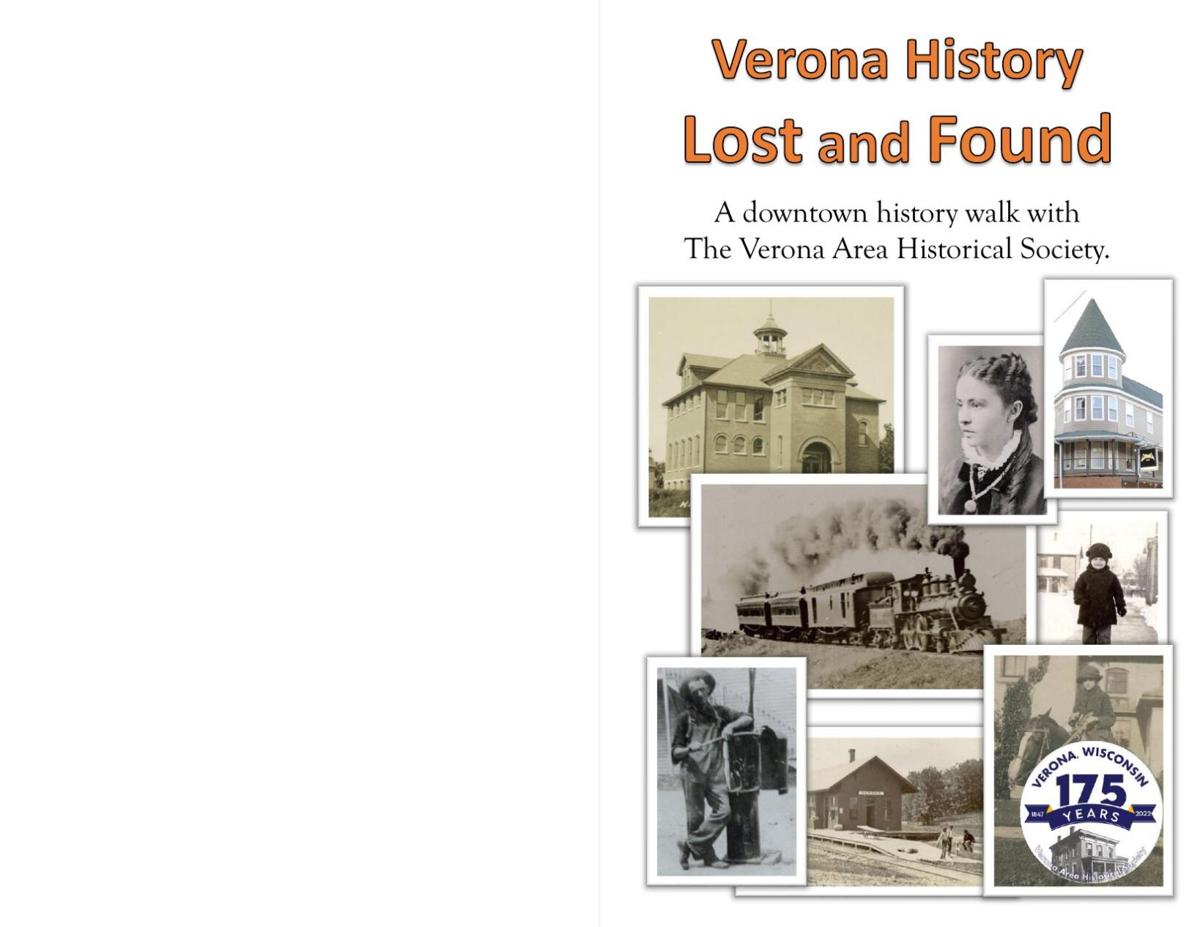
Looking south down Main Street from Verona Avenue, circa 1910.
When you think about who keeps local history alive in smaller cities or towns that are not routinely the subject of books and documentaries or don’t have their own history museums, it usually takes at least one local resident who totally geeks out about the past to keep it living in the present.
For Hometown, U.S.A., it’s Verona Area Historical Society president Jesse Charles’ energetic enthusiasm for local history that has helped reinvigorate the past in the minds of residents today.
Over the month of June, the historical society has been facilitating a variety of activities to commemorate Verona’s demisemiseptcentennial – or 175 years – since becoming a town in 1847.
As part of those celebrations, last weekend Charles led a group of 25 people around downtown Verona sharing interesting stories of historic people, homes, and businesses that have occupied various sites near Main Street over the decades.
“Today you will all be time traveling,” Charles said. “After today, things will start to change in your mind. You will start seeing things that had been there before and you will start to see them there every time. It’s a whole different way to enjoy our hometown.”
The tour was titled ‘Verona History Lost and Found’ because some of the buildings discussed are still standing and have been preserved, while other stops along the way discussed buildings that have been torn down and replaced.
Participants were provided a booklet filled with historical photos and dates about the residents or businesses that formerly occupied over a dozen stops along Main Street.
Along the way, Charles provided additional details and shared chronicles of bygone days. At some stops, participants on the tour even helped fill in a few gaps in his historical accounts or shared their own memories and anecdotes about the buildings.
One common theme that became a running joke by the end of the tour is that the majority of buildings Charles stopped at have housed a post office at some point in Verona’s history.
While Charles is a major history geek, the tour participants were his guinea pigs. He said it was the first walking downtown history tour that he had ever conducted, so he was still working out the kinks. Originally scheduled to run for 75 minutes, the tour stretched out to 135 minutes.
“One big change I'll be making is to not end the tour just on the sad story of the [loss of the] Sharpe House, but rather on the more positive note that we still have so many historically interesting places left in Verona,” Charles told the Press. “They aren't all obvious, but they are there, and letting people know about them is the first step in helping people care about these places.”
While Charles doesn't currently have any more of the walking tours scheduled, he said additional runs of the guided downtown Verona history walks on South Main Street will be happening in late Summer.
For details about future tours, visit veronahistory.com/175 later this summer.

Head downtown to discover the historical uses of some of Verona’s most popular destinations for yourself. We’ve mapped out the walking tour for you to follow along.

Stop 1: 101 N. Main St.
Historically: Built in 1848, according to local histories, possibly as late as the 1860s. Home to the Matts family, one of the first settlers of Verona. A post office. House of Flowers flower shop. The Purple Goose clothing boutique. Apartments upstairs.
Local histories indicate the building was built in 1848. Some experts believe it could be as late as the 1860s, but we go with 1848 because of local sources. Built by the Josiah and Lydia Matts family. They purchased the east half of our downtown area from the U.S. government on 5/22/1845. Lydia’s brother-in-law purchased the east half of our downtown that same day. The Matts’ son William G.L. was a Civil War Veteran and POW. His last home was also featured in this tour.
Today: Kismet Books bookstore

Stop 2: 104 N. Main St.
Historically: Verona’s first library with 250 books at the start. Bank of Verona. A post office. Mount Vernon Telephone Company.
A brick building formerly stood here. The Bank of Verona was organized in 1903 with $15,000 capital. The bank opened in this building in 1904. The post office was here by 1911, and until the late 1940s. The Verona Library started in part of this building in 1947 with 250 books they got from the UW Library Extension. They later moved out to a few different locations over time before their building today. The police office was in here at one time. At one point the switchboard of the Mount Vernon Telephone Company was in the upper floor of this building. The brick building was torn down in the 1960s.
Today: Walgreens pharmacy

Stop 3: 101 E. Verona Ave.
Historically: Built in the 1850s. Was likely a doctor’s office in the beginning. Later a hotel, saloon, stagecoach stop, and livery stable. Oxen drawing carts of lead would stop there. One owner, Fred Nicolson, was convicted in 1933 of conspiring with criminals in Chicago to transport stolen cars to Verona. This has been confirmed with newspaper articles from the time. Locals remember hearing that the “gangsters” stripped the vehicles in the barn behind the Eagle's Nest.
Was the Eagle’s Nest tavern for decades, owned by the same family (The Jim and Clara Scharer family) from 1936-1970. The Wisconsin architect Frank Lloyd Wright was a regular at the tavern, notorious for not paying his bills when he left, but a check always arrived later in the mail. It had the only pay phone in the 1940s. Was a popular spot for Badger bus coaches with students to stop. The business was friendly to “hobos” or people who rode the rails, offering food leftovers for free.
Today: Verona Mart Mobil gas station

Stop 4: 113 S. Main St.
Historically: Fischl Bowling Alley. A soda fountain and bar with a short order cooking area. A post office. Dale Hagen’s barbershop. Little Flower Shoppe.
Karl “Charley” Fischl built bowling alleys in the back of this building in 1928, according to a recorded interview with this son Norman. The building’s long shape is a reminder of those alleys. The front of the building may have been there earlier than 1928, we aren’t sure. The alleys were shut down for two years starting in 1930 due to the great depression. The end of prohibition in 1933 was a big deal for the Fischl’s, who added a bar. In 1933 a ten ounce glass of beer was nickel, normal recalls. The business was later run by Charley’s son “Gil”, who is well remembered.
Today: Schmitt Law Office

Stop 5: 119 S. Main St.
Historically: Verona’s first Baptist church, moved to this location by Civil War Veteran Jesse Meyers in 1890. A post office. A doctor’s office. Hinrichs Funeral Home and furniture store. Matts Radio Repair Shop. A ballroom upstairs. Western Auto. Sweet Street Bakery. A hardware store (Blizard’s, with only one “z”) that also sold gifts and beekeeping supplies. Verona’s first video rental store. Moscato's Italian Restaurant.
Today: Avantis Italian Restaurant

Stop 6: 125 S. Main St.
Historically: A doctor’s office in the 1800s. A flower shop. Longtime private residence.
Today: The Sow’s Ear yarn and coffee shop

Stop 7: 103 E. Park Lane
Historically: The Lillesand House – first a livery house for docking horses, then later the home and office of a country veterinarian. Doctor Joel Lillesand and his wife Viola (former Verona school teacher). Their son Alan was a WWII pilot and later a Verona math teacher.
Today: A private residence

Stop 8: 201 S. Main St.
Historically: Baptist church. The Matts family leased the land in 1861 and the church once had stables behind it. The first Baptist church building on this site was moved to become Avantis today. The second church here burned down, and the current building started as the third church.
Today: Memorial Baptist Church, the longest still-running church in Verona (organized 1855)

Stop 9: 215 S. Main St.
Historically: William Matts’ final home. After returning from the Civil War, William Matts lost three of his children in one week in 1880 to Diptheria. He died poor and alone in this house. The grocery store that later became Miller and Sons would freely provide him the flour they could not sell because it was bug-infested, which became a part of his of sustenance in his final years.
Today: Essentials hair salon

Stop 10: 219 S. Main St.
Historically: Blacksmith shop. Car dealership. At one point, horses were being shoed and cars were sold simultaneously out of the same building.
Today: EZ Plumbing Company

Stop 11: 101 W. Railroad St.
Historically: The train depot was located immediately behind the current depot-styled park shelter. The resources brought to Verona by railroad in the 1880s helped transform the community. There was also a telegraph station located in the depot.
Today: Hometown Junction Park, a popular spot to rest while bicycling the Military Ridge Trail and also home to the Verona Downtown Farmers’ Market.

Stop 12: 102 W. Railroad St.
Historically: Previously called the ‘Auditorium,’ it has housed a long line of restaurants, bars, and inns. At one point by the 1930s, there were 13 rooms to rent. There were movies projected on the side of the building and on Saturdays the city kids and farm kids would mix and mingle there. There was a bar with a front room that was compliant during the Prohibition Era but the back room was a speakeasy that got busted by police. Broken Spur Saloon and Grill. The Dog House. An Italian restaurant.
Today: Cahoots bar

Stop 13: 300 S. Main St.
Historically: Built in the 1840s and once known as the ‘Verona House,’ it has always been a gathering space. It was the Town Pump from as early as the 1940s. It was owned by the Kahr Family from 1968 to 2000 – a restaurant with culinary experiments like frog legs (secretly chicken legs), a dance floor that welcomed popular Nashville country music acts, a backyard biergarten, and controversial gogo dancing in the 1970s. Most recently, it was Tuvalu Coffeehouse from 2007 to 2021, which also offered live music acts as well as coffee, tea, and baked goods.
Today: Alice Good coffee

Stop 14: 210 S. Main St.
Historically: Stewart and Miller, a grocer and home goods store. Besides for selling meats and dry goods, there was also clothing, radio repair, gifts, school supplies, a gas pump, Harley Davidson motorcycles and a post office. This southeast part of the current Miller and Sons parking lot was home to a Methodist church. The Methodist Conference sold the building for $2,000 in 1932 to the Salem Evangelical and Reformed Church (later the United Church of Christ).
Today: Miller and Sons Supermarket, Verona’s longest still-running business

Stop 14: 210 S. Main St.
Historically: Stewart and Miller, a grocer and home goods store. Besides for selling meats and dry goods, there was also clothing, radio repair, gifts, school supplies, a gas pump, Harley Davidson motorcycles and a post office. This southeast part of the current Miller and Sons parking lot was home to a Methodist church. The Methodist Conference sold the building for $2,000 in 1932 to the Salem Evangelical and Reformed Church (later the United Church of Christ).
Today: Miller and Sons Supermarket, Verona’s longest still-running business

Stop 15: 104 S. Main St.
Historically: Home to Dr. Walter Stebbins, who did house calls, first by horse and buggy and later in a Ford. The home was later owned by Dr. Howard Sharpe. It was known for being a “palatial” type estate, but the owners were reclusive. The Sharpes offered the home to the Village of Verona, but were declined. Later the home was acquired by the village of Verona. The home later became a police station. Eventually it was demolished in the late 1980s after being rezoned for commercial use and a Hardee’s was built there. School students protested the building of the Hardee’s with signs that read “peace, not grease.”
Today: Park Bank



























